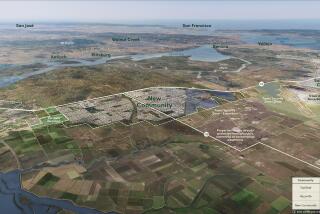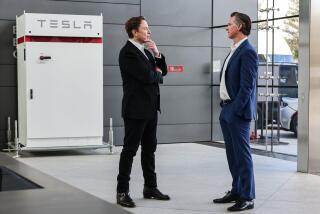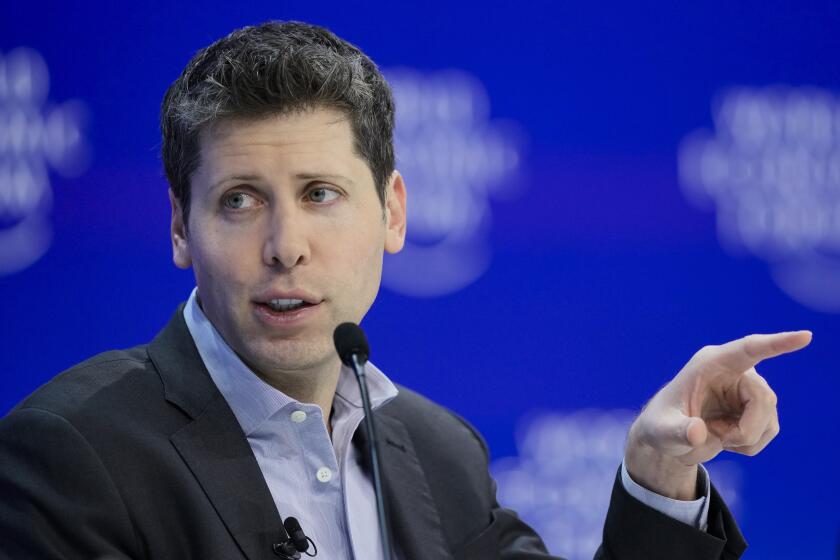Cisco Systems helps build prototype for instant ‘city in a box’
- Share via
Reporting from Incheon, South Korea — It’s a product like no other — a complete city for a million people.
As tens of millions of people across the developing world migrate from the countryside to new cities, Cisco Systems Inc. is helping build a prototype here for what one developer describes as an instant “city in a box.” Cisco is wiring every tech nook and cranny of the new city, making it one of the most technologically sophisticated urban centers on the planet.
Delegations of Chinese government officials looking to buy their own cities of the future are descending on New Songdo City, a soon-to-be-completed metropolis about the size of downtown Boston that serves as a showroom model for what is expected to be the first of many assembly-line cities. In addition to state-of-the-art information technology, Songdo will emit just one-third of the greenhouse gases of a typical city of similar size.
Cities of a million-plus population are popping up across the developing world, but the foremost market for the prototype here is China, where a massive demographic shift from rural to urban already is underway, requiring hundreds of new cities.
“They come in here and say, ‘I’ll take one of these,’” said Richard Warmington, the former head of Hewlett-Packard Co.’s Korea operation and a Saratoga, Calif., resident who is president of Chadwick International School, which is setting up a campus in Songdo.
The potential is so big that executives at Cisco, the key tech partner for the development, get giddy talking about what could be a $30-billion business over coming years for the San Jose networking giant. Just a year ago, the usually buttoned-down Cisco Chief Executive John Chambers engaged in a night of “love shots” — locked-elbow drinking toasts — with South Korean President Lee Myung-bak to seal the Songdo deal Korean-style.
It’s easy to see why Cisco is intoxicated with the possibilities: According to a study by investment bank CIBC World Markets, governments are expected to spend $35 trillion on public works projects during the next 20 years. In Songdo alone, Cisco sold 20,000 units of its advanced video-conferencing system called Telepresence — a billion-dollar order — almost before the ink had dried on the contract, said developer Stan Gale, the chief visionary of the project.
“Everything will be connected — buildings, cars, energy — everything,” said Wim Elfrink, Cisco’s Bangalore-based chief globalization officer. “This is the tipping point. When we start building cities with technology in the infrastructure, it’s beyond my imagination what that will enable.”
The audacious plan is rising up from former mud flats along the Yellow Sea. Cisco and New York City-based Gale International hope the privately funded $35-billion Songdo project leads to at least 20 similar developments in China, India, Vietnam and other countries in coming years. Much of Songdo will be completed in 2014.
“Five hundred cities are needed in China; 300 are needed in India,” said Gale, an exuberant, arm-waving developer who believes Songdo will be his legacy.
The project calls for wired everything — an urban center where networking technology is embedded into buildings from the ground up and every home, school and government agency is equipped with sophisticated Telepresence video technology — what in Cisco mantra is called Smart+Connected Communities.
It looks good on paper. But will those Chinese officials buy this tech utopian vision?
“It seems a little speculative,” Broadpoint AmTech analyst Mark McKechnie said. Still, he added, “If you want to be around, you have to have a 10-year plan. If this doesn’t develop, at least they’ll learn something new they can apply to different businesses.”
There’s also a question of how many whistles and bells developing countries are willing to pay for. For some local officials from China and elsewhere, Songdo, which has a 100-acre park and Jack Nicklaus golf course, is a bit like visiting a luxury auto dealer when all you can afford is a Honda Civic.
Cisco is using its Shanghai World Expo pavilion, which displays a compelling video detailing a totally linked city, to sell its technology. Government officials are then invited to hop on a plane for the 90-minute flight to Incheon.
“There will be at least 100 new cities with a minimum population of 1 million each being built in China in the next three years,” said Anthony Elvey who, as director of Cisco’s Expo pavilion, gives tours to Chinese provincial officials, each hoping to outdo the other in creating an instant city that will attract job-creating investments.
So far, Cisco has signed deals with two Chinese municipalities. It will be the main networking infrastructure provider for Chongqing, which has a population of more than 31 million in southwestern China. And Cisco and Gale will provide a city-scale development in Changsha in Hunan province.
“These guys can snap their fingers and put all this infrastructure in place,” Elvey said.
Boudreau writes for the San Jose Mercury News/McClatchy.






